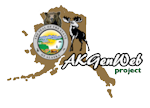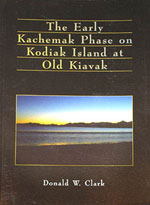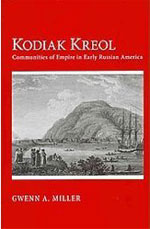

BIBLIOGRAPHY


|
|
BIBLIOGRAPHY
|
| Many libraries are regularly increasing their offerings of ebooks in a variety of formats. To read a book listed below, please visit some of the eLibraries, such as Internet Archives and Project Gutenburg. And, if you find a helpful ebook available, please let us know, and we will add the link to our Bibliography below. | |
| A history of the Orthodox Church in Alaska, 1794-1917 | by Bishop Gregory (Afonsky). Published/Created: Kodiak, Alaska: St. Herman’s Theological Seminary, c1977. Description: vi, 106 p.: ill. ; 22 cm. Notes: Bibliography: p. 101-105. |
| Alaska’s Konyag Country | by Yule Chaffin, Trisha Hampton Krieger, Michael Rostad. Published/Created: [Anchorage?]: Chaffin, c1983. Description: 269, 16 p., [2] p. of plates: ill. (some col.) ; 27 cm. Notes: "Kodiak from sea otter settlement to king crab capitol. History of hunting and fishing industries, island villages, and scenic beauty." Rev. ed. of: Koniag to king crab. [1968, c1967] Includes index. Bibliography: p. 259-262. |
| Archaeology and the Capitalist World System: a Study from Russian America | Crowell, Aron. , with an appendix by Donald W. Clark (New York: Plenum Press, 1997), 286 pp., hardbound, ISBN0306456699, 233 Spring Street, New York NY 10013-1578. LC97-40644. Look at the disruption of an indigenous culture caused by the incursion of capitalism, focusing on findings from excavation of the 1780s fur trading site of Three Saints Harbor, Kodiak Island and contemporary eyewitness reports. |
| Derevnia’s daughters: saga of an Alaskan village | by Lola Harvey. Published/Created: Manhattan, Kan., USA: Sunflower University Press, c1991. Description: xiii, 489 p.: ill. ; 23 cm. ISBN: 089745135X Notes: Includes bibliographical references (p. [468]-472) and index. |
Early Kachemak Phase on Kodiak Island at Old Kiavak | Clark, Donald W. (Hull, Quebec: Canadian Museum of Civilization, 1997), 129 pp., paper, ISBN 0660159678. Report describes the University of Wisconsin's 1963 excavations on Kodiak Island. Canadian Museum Of Civilization, 1997, 129 pages, 26 figures, 15 tables, 18 photos. This site report describes excavations from 1963 on Kodiak Island, Alaska, and defines an early local phase of the Kachemak tradition called the Old Kiavak phase. Information remains insufficient to fully describe this phase as well as the third and fourth millennium B.P occupation at the site owing to poor recovery of organic artifacts and a very sparse inventory from the earliest levels. Comparisons with other Early Kachemak components found on Kodiak Island and elsewhere show considerable variation within the tradition. The local Old Kiavak phase represents the early to middle time range of the Kachemak tradition and is part of a more broadly defined Early Kachemak regional phase. Radiocarbon dating of the Old Kiavak site indicates that occupation extends from 3400 B.P or earlier, but with several periods of abandonment. There is little temporal gap between the Kachemak tradition at Old Kiavak and the antecedent Ocean Bay tradition (which is barely present). The succeeding Late Kachemak phase, found elsewhere in the area at Three Saints, began about 2200 B.P and probably extended to about 900 B.P. No discrete Late Kachemak occupation is recognized at Old Kiavak, although judging from styles of artifacts recovered, the possibility of minor use of the site during this phase cannot be excluded. The site was reoccupied approximately seven or eight centuries ago, but remains from this early Koniag tradition occupation tend to be patchy and mixed with materials of the main, Old Kiavak, phase. At the north flank of the site are additional Koniag deposits and a housepit, possibly from full Koniag tradition times. Between A.D. 1500 and 1800, late Koniag occupation was focused in a large village located a hundred metres from the Old Kiavak site. Finally, there was late historic seasonal occupation of the site mound from approximately AD. 1890 to 1910. Few data from Old Kiavak bear on the Early Kachemak-Ocean Bay succes-sion, but evidence for technological continuity from the Ocean Bay to the Kachemak tradition has been found at Site AFG-088, located on Afognak Island of the Kodiak group. The transitional complex is tentatively called the "Afognak phase". Radiocarbon dating indicates that this phase began about 3400 or 3500 B.P (uncalibrated age), slightly earlier than the Old Kiavak phase, although the two may overlap temporally. The seven millennia of cultural continuity accorded to Kodiak history and prehistory have an important bearing on the past of the northern North Pacific region as well on Eskimo origins. |
| Entangling Net : Alaska's Commercial Fishing Women Tell Their Lives | Fields, Leslie Leyland. (Urbana : University of Illinois Press, 1997), 156 pp., cloth, ISBN 0252022203; paper, ISBN0252065654. LC 96-4492. The author, a fisher herself, writes about her experiences in Kodiak and includes the narratives of other women who reflect on their fishing careers in Alaska. |
| Kodiak and Afognak life, 1868-1870 | by Eli Lundy Huggins. With the journals of John A. Campbell and Frederick Sargent; [all] edited, with an introduction, by Richard A. Pierce. Published/Created: Kingston, Ont., Canada: Limestone Press, 1981. Related Names: Campbell, John A. (John Augustus), 1843-1875. Sargent, Frederick, 1828-1911. Pierce, Richard A. (Richard Austin), 1918- Description: xiv, 163 p., [8] p. of plates : ill. ; 24 cm. ISBN: 0919642969 |
| Kodiak Coastal Defense System at Fort Greely During World War II : U.S. Army, Fort Greely, Kodiak, Alaska | McAlister, Emily and Melinda Tsu. (Anchorage: Montgomery Watson for U.S. Army Corps of Engineers, 1999) 22 pp., paper, request from Montgomery Watson, 4100 Spenard Road, Anchorage AK 99517-2901. Illustrated pamphlet describing this Army post near Kodiak. At full capacity, Fort Greely housed nearly 750 officers and 10,000 soldiers, waiting for an attack by Japan which never came. |
| Kodiak Bears & the Exxon Valdez | Richardson, Tim, and Dave Cline, editors. (Kodiak: Kodiak Brown Bear Trust, 2000), 170 pp., paper, ISBN 0970602103, 1390 Buskin River Road, Kodiak, AK 99615. Conservation saga of the oil spill and its aftermath in Kodiak Archipelago. |
Kodiak Kreol: communities of empire in early Russian America | by Gwenn A. Miller, Cornell University Press, 2010. ISBN: 9780801446429 "In this fascinating book, Gwenn A. Miller skillfully explores the Russian colonization of Alaska, one of the most neglected stories of the early American past. Using Russian-language sources, Miller focuses on the intimate bonds that formed between Alutiiq people and newcomers. She not only shines light on the complex history of the Pacific Northwest but also offers a much broader analysis of how colonialism shaped family and gender relations."---Claudio Saunt, University of Georgia, author of Black, White, and Indian: Race and the Unmaking of an American Family "Kodiak Kreol offers a nuanced and engaging account of the first years of contact between Russians and native peoples off the Alaskan coast. Miller's portrait of the intimate history of relations on Kodiak Island---between men and women, children and parents, priests and their flocks---is truly original."---Willard Sunderland, University of Cincinnati, author of Taming the Wild Field: Colonization and Empire on the Russian Steppe "Most Europeans reached the Americas from across the Atlantic Ocean. The Russians, in contrast, approached North America from the west, having already acquired extensive colonial experience in Siberia. Their first---and only---overseas colony was in Alaska. In Kodiak Kreol, Gwenn A. Miller offers a new geographic and imperial perspective on colonial encounters in early America. Specialists in other empires in the early Americas and beyond will find this fascinating work rich in comparative perspectives and insights on a host of subjects, including labor, marriage, religion, sexuality, and, above all, the Kreols---the mixed-race children of Russian men and indigenous women---who are the special focus of this book."---Alison Games, Georgetown University, author of The Web of Empire; English Cosmopolitans in an Age of Expansion, 1560-1660 From the 1780s to the 1820s, Kodiak Island, the first capital of Imperial Russia's only overseas colony, was inhabited by indigenous Alutiiq people and colonized by Russians. Together, they established an ethnically mixed Kreol community. Against the backdrop of the fur trade, the missionary work of the Russian Orthodox Church, and competition among Pacific colonial powers, Gwenn A. Miller brings to light the social, political, and economic patterns of life in the settlement, making clear that Russia's modest colonial effort off the Alaskan coast fully depended on the assistance of Alutiiq people. In this context, Miller argues, the relationships that developed between Alutiiq women and Russian men were critical keys to the initial success of Russia's North Pacific venture. Although Russia's Alaskan enterprise began some two centuries after other European powers---Spain, England, Holland, and France---started to colonize North America, many aspects of the contacts between Russians and Alutiiq people mirror earlier colonial episodes: adaptation to alien environments, the "discovery" and exploitation of natural resources, complicated relations between indigenous peoples and colonizing Europeans, attempts by an imperial state to moderate those relations, and a web of Christianizing practices. Russia's Pacific colony, however, was founded on the cusp of modernity at the intersection of earlier New World forms of colonization and the bureaucratic age of high empire. Miller's attention to the coexisting intimacy and violence of human connections on Kodiak offers new insights into the nature of colonialism in a little-known American outpost of European imperial power. |
| Now It Can Be Told : Stories of Alaskan Pioneer Ranchers | Fields, Wanda Marie. (Anchorage: Publications Consultants, 2000), 311 pp., cloth, ISBN 1888125446, order from the author, P.O. Box 25, Kodiak, AK 99615. Arriving on Kodiak Island as Baptist mission houseparents in 1949, the author and her husband soon turned to cattle ranching. Illustrated with hundreds of color photographs, this is the story of traditional Western ranching adapted to a very non-traditional location. |
| Orthodox Alaska: A Theology of Mission | by Michael Oleksa, St. Vladimir's Seminary Press, Crestwood, NY 10707. A history of the Russian Orthodox Church in Alaska. |
| Penny: Half Coyote, or Half Wolf - and All Heart | Moore, Delores L. (Anchorage, AK: Lighthouse Publications, 1966), 155 p., paper, ISBN1888844000 (PO Box 210288, Anchorage, AK 99521-0288). LC96-76842. A dog shares the life of a family that moves to Kodiak following the Good Friday Earthquake in 1964. |
| Road System Guide to Kodiak Island World War II Sites | Stoltenberg, Loretta. (Kodiak : Alaska State Parks, Kodiak District Office, 1997), 28 pp., paper, request from Fort Abercrombie, 1400 Abercrombie Drive, Kodiak, AK 99615. Specialized guide for those interested in Kodiak and/or World War II. |
| Russian discovery of the Aleutian and Kodiak Islands | foreword by Winston L. Sarafian; translated by Svetlana Potton ; edited with an introduction by J.L. Smith. Published/Created: Anchorage, Alaska: White Stone Press, 2003. Description: vi, 151 p.: ill., maps ; 22 cm. ISBN: 0972454306 Contents: Ch. 1. Early voyages to the Aleutian Islands / by V.I. Grekov -- Ch. 2. Voyages to the Commander and Copper Islands, 1743-1746 / by E.S. Basov -- Ch. 3. The voyage of Cossack Studentsov, 1757-1761 -- Ch. 4. The voyage to Unmak [i.e. Umnak] and Unalaska Islands, 1758-1762 / by Savin Ponomariov and Stefan Glotov -- Ch. 5. The voyage to the Aleutian Islands, 1758-1763 / by Dmitri Pankov -- Ch. 6. The voyage to the Aleutian Islands, 1760-1764 / by Andrian Tolstykh -- Ch. 7. The discovery of Kodiak Island, 1762-1766 / by S.G. Glotsov. Notes: Includes bibliographical references and index. |
| Salmon from Kodiak : an history of the salmon fishery of Kodiak Island, Alaska | by Patricia Roppel. Published/Created: [Anchorage, Alaska]: Alaska Historical Commission, c1986. Description: xi, 355 p.: ill. ; 22 cm. ISBN: 0943712203 (pbk.) Notes: Map on lining papers. Includes index. Bibliography: p. 336. |
| The Bein-Pot: 300 years of Beins family history (1680-1980) | written and compiled by Sally Giggey Lowery. Published/Created: [Fairbanks, Alaska] (1021 Kodiak St., Fairbanks 99701) : S.G. Lowery, 1980. Description: 81, 9 p., [8] leaves of plates: ill., maps, ports; 30 cm. Notes: Includes index. Bibliography: p. 4 (1st group) |
| The flying, fighting weathermen of Patrol Wing Four, 1941-1945: Memoirs of Paul E. Carrigan | memoirs of Paul E. Carrigan, Description: U.S. Navy : Kodiak, Dutch Harbor, Umnak, Cold Bay, Adak, Amchitka, Kiska, Shemya, Attu and The Empire Express to Paramushiro. Published/Created: [Forked River, N.J.] : Regal-Lith Printers, c2002. Description: 3 v.: ill. ; 28 cm. |
| Trade and Commerce in Alaska's Past: Papers Presented at the Annual Meeting of the Alaska Historical Society, Kodiak, Alaska, November 3-5,1994 | (Anchorage: Alaska Historical Society, 1994), 66 p., ISBN 0940521032, comb-bound, P.O. Box 100299, Anchorage, AK 99510-0299. Five papers presented at the conference. wln96-155345. |


Kodiak Island Borough AKGenWeb Copyright This page was last updated 12/26/2023 |